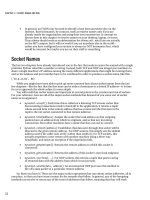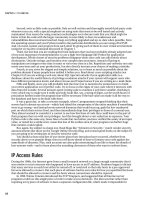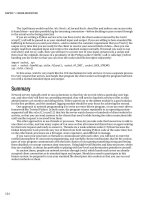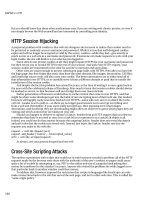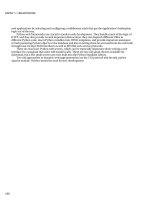Python geospatial development, 2nd edition
Bạn đang xem bản rút gọn của tài liệu. Xem và tải ngay bản đầy đủ của tài liệu tại đây (40.45 MB, 508 trang )
www.it-ebooks.info
Python Geospatial
Development
Second Edition
Learn to build sophisticated mapping applications from
scratch using Python tools for geospatial development
Erik Westra
BIRMINGHAM - MUMBAI
www.it-ebooks.info
Python Geospatial Development
Second Edition
Copyright © 2013 Packt Publishing
All rights reserved. No part of this book may be reproduced, stored in a retrieval
system, or transmitted in any form or by any means, without the prior written
permission of the publisher, except in the case of brief quotations embedded in
critical articles or reviews.
Every effort has been made in the preparation of this book to ensure the accuracy
of the information presented. However, the information contained in this book is
sold without warranty, either express or implied. Neither the author, nor Packt
Publishing, and its dealers and distributors will be held liable for any damages
caused or alleged to be caused directly or indirectly by this book.
Packt Publishing has endeavored to provide trademark information about all of the
companies and products mentioned in this book by the appropriate use of capitals.
However, Packt Publishing cannot guarantee the accuracy of this information.
First published: December 2012
Second Edition: May 2013
Production Reference: 1170513
Published by Packt Publishing Ltd.
Livery Place
35 Livery Street
Birmingham B3 2PB, UK.
ISBN 978-1-78216-152-3
www.packtpub.com
Cover Image by Karl Moore ()
www.it-ebooks.info
Credits
Author
Proofreaders
Erik Westra
Stephen Silk
Katherine Tarr
Reviewers
Will Cadell
Indexers
Richard Marsden
Hemangini Bari
Silas Toms
Rekha Nair
Tejal Daruwale
Acquisition Editor
Kartikey Pandey
Graphics
Ronak Dhruv
Lead Technical Editor
Susmita Panda
Technical Editors
Sharvari Baet
Meenakshi Gupta
Chirag Jani
Abhinash Sahu
Production Coordinator
Manu Joseph
Cover Work
Manu Joseph
Project Coordinator
Arshad Sopariwala
www.it-ebooks.info
About the Author
Erik Westra has been a professional software developer for over 25 years, and
has worked almost exclusively in Python for the past decade. Erik's early interest in
graphical user-interface design led to the development of one of the most advanced
urgent courier dispatch systems used by messenger and courier companies worldwide.
In recent years, Erik has been involved in the design and implementation of systems
matching seekers and providers of goods and services across a range of geographical
areas. This work has included the creation of real-time geocoders and map-based
views of constantly changing data. Erik is based in New Zealand, and works for
companies worldwide.
I would like to thank Ruth, the love of my life, for all of her support
and encouragement.
www.it-ebooks.info
About the Reviewers
Richard Marsden has over 15 years of professional software development
experience. After starting in the field of geophysics and oil exploration, he has spent
the last ten years running the Winwaed Software Technology LLC, an independent
software vendor. Winwaed specialize in geospatial tools and applications including
web applications, and operate the website for
tools and add-ins for Microsoft's MapPoint product.
Richard also manages the technical aspects of the EcoMapCostaRica.com project
for the Biology Department at the University of Dallas. This includes the website,
online field maps, field surveys, and the creation and comparison of panoramic
photographs.
Richard is also active in the field of natural language processing, especially with
Python's NLTK package.
Will Cadell is a principal consultant with Sparkgeo.com. He builds next generation
web mapping applications, primarily using Google Maps, geoDjango, and PostGIS.
He has worked in academia, government, and natural resources but now mainly
consults for the start-up community in Silicon Valley. His passion has always been
the implementation of geographic technology and with over a billion smart, mobile
devices in the world it's a great time to be working on the geoweb.
Will lives in Prince George, Northern British Columbia, and when he's not writing
code or talking about geographic web technology you can find him on a ski hill with
his family.
www.it-ebooks.info
Silas Toms is a GIS programmer with ICF International. His main professional
interests are programming in Python and automation of large-scale environmental
impact analyses. He has lived in San Francisco for 6 years while finishing a masters
in GIS at San Francisco State University on temperature interpolation. He wishes to
thank his girlfriend and his family for being supportive of his many interests.
www.it-ebooks.info
www.PacktPub.com
Support files, eBooks, discount offers and more
You might want to visit www.PacktPub.com for support files and downloads related
to your book.
Did you know that Packt offers eBook versions of every book published, with PDF
and ePub files available? You can upgrade to the eBook version at www.PacktPub.
com and as a print book customer, you are entitled to a discount on the eBook copy.
Get in touch with us at for more details.
At www.PacktPub.com, you can also read a collection of free technical articles,
sign up for a range of free newsletters and receive exclusive discounts and offers
on Packt books and eBooks.
TM
Do you need instant solutions to your IT questions? PacktLib is Packt's online
digital book library. Here, you can access, read and search across Packt's entire
library of books.
Why Subscribe?
• Fully searchable across every book published by Packt
• Copy and paste, print and bookmark content
• On demand and accessible via web browser
Free Access for Packt account holders
If you have an account with Packt at www.PacktPub.com, you can use this to access
PacktLib today and view nine entirely free books. Simply use your login credentials
for immediate access.
www.it-ebooks.info
www.it-ebooks.info
Table of Contents
Preface1
Chapter 1: Geospatial Development Using Python
7
Python
Geospatial development
Applications of geospatial development
Analyzing geospatial data
Visualizing geospatial data
Creating a geospatial mash-up
Recent developments
Summary
Chapter 2: GIS
7
9
12
12
14
16
17
19
21
Core GIS concepts
21
Location22
Distance25
Units27
Projections29
Cylindrical projections
Conic projections
Azimuthal projections
The nature of map projections
29
31
32
33
Coordinate systems
34
Datums36
Shapes37
GIS data formats
39
Working with GIS data manually
41
Summary
49
www.it-ebooks.info
Table of Contents
Chapter 3: Python Libraries for Geospatial Development
51
Reading and writing geospatial data
51
GDAL/OGR52
GDAL design
GDAL example code
OGR design
OGR example code
52
55
56
57
Documentation58
Availability58
Dealing with projections
59
pyproj59
Design60
Proj60
Geod61
Example code
62
Documentation63
Availability64
Analyzing and manipulating geospatial data
66
Shapely66
Design66
Example code
68
Documentation69
Availability69
Visualizing geospatial data
70
Mapnik71
Design72
Example code
74
Documentation76
Availability76
Summary
77
Chapter 4: Sources of Geospatial Data
79
Data format
Obtaining and using OpenStreetMap data
81
82
Data format
Obtaining and using TIGER data
86
87
Sources of geospatial data in vector format
80
OpenStreetMap80
TIGER84
Natural Earth
Data format
Obtaining and using Natural Earth vector data
[ ii ]
www.it-ebooks.info
88
89
89
Table of Contents
Global, self-consistent, hierarchical, high-resolution
shoreline database (GSHHS)
90
World Borders Dataset
92
Data format
Obtaining the GSHHS database
Data format
Obtaining World Borders Dataset
91
92
93
93
Sources of geospatial data in raster format
93
Landsat94
Data format
Obtaining Landsat imagery
95
95
Natural Earth
Data format
Obtaining and using Natural Earth raster data
98
99
99
Global Land One-kilometer Base Elevation (GLOBE)
100
National Elevation Dataset (NED)
102
Data format
Obtaining and using GLOBE data
Data format
Obtaining and using NED data
Sources of other types of geospatial data
GEOnet Names Server
Data format
Obtaining and using GEOnet Names Server data
Geographic Names Information System (GNIS)
Data format
Obtaining and using GNIS Data
Choosing your geospatial data source
Summary
Chapter 5: Working with Geospatial Data in Python
100
101
103
103
105
106
107
107
107
108
109
109
110
111
Pre-requisites111
Reading and writing geospatial data
112
Task – calculate the bounding box for each country in the world
112
Task – save the country bounding boxes into a shapefile
114
Task – analyze height data using a digital elevation map
119
Changing datums and projections
126
Task – change projections to combine shapefiles using geographic
and UTM coordinates
127
Task – change datums to allow older and newer TIGER data to
be combined
132
Representing and storing geospatial data
135
Task – define the border between Thailand and Myanmar
136
[ iii ]
www.it-ebooks.info
Table of Contents
Task – save geometries into a text file
Performing geospatial calculations
Task – identify parks in or near urban areas
Converting and standardizing units of geometry and distance
Task – calculate the length of the Thai-Myanmar border
Task – find a point 132.7 kilometers west of Soshone, California
Exercises
Summary
Chapter 6: GIS in the Database
140
141
141
146
147
154
156
158
159
Spatially-enabled databases
159
Spatial indexes
160
Open source spatially-enabled databases
163
MySQL163
PostGIS168
Installing and configuring PostGIS
168
Using PostGIS
170
Documentation172
Advanced PostGIS Features
173
SpatiaLite174
Installing SpatiaLite
174
Installing pysqlite
175
Accessing SpatiaLite from Python
175
Documentation176
Using SpatiaLite
177
SpatiaLite capabilities
178
Commercial Spatially-enabled database
179
Oracle180
MS SQL Server
180
Recommended best practices
181
Using the database to keep track of spatial references
181
Using the appropriate spatial reference for your data
183
Option 1 – using a database that supports geographies
Option 2 – transform features as required
Option 3 – transform features from the outset
When to use unprojected coordinates
184
185
185
185
Avoiding on-the-fly transformations within a query
Don't create geometries within a query
186
187
Knowing the limits of your database's query optimizer
189
Using spatial indexes appropriately
188
MySQL189
PostGIS191
SpatiaLite193
[ iv ]
www.it-ebooks.info
Table of Contents
Working with geospatial databases using Python
195
Prerequisites195
Working with MySQL
195
Working with PostGIS
199
Working with SpatiaLite
201
Comparing the databases
204
Summary
205
Chapter 7: Working with Spatial Data
207
About DISTAL
207
Designing and building the database
211
Downloading the data
216
World Borders Dataset
216
GSHHS216
GNIS216
GEOnet Names Server
217
Importing the data
217
World Borders Dataset
218
GSHHS220
US place name data
222
Worldwide places' name data
227
Implementing the DISTAL application
229
The shared "database" module
232
The "select country" script
233
The "select area" script
236
Calculating the bounding box
Calculating the map's dimensions
Setting up the data source
Rendering the map image
241
242
245
246
The "show results" script
248
Identifying the clicked-on point
Identifying features by distance
Displaying the results
249
250
259
Application review and improvements
262
Usability262
Quality264
Place name issues
Lat/Long coordinate problems
264
264
Finding the problem
Improving performance
Calculating the tiled shorelines
266
269
271
Performance266
[v]
www.it-ebooks.info
Table of Contents
Using tiled shorelines
Analyzing performance improvement
280
282
Summary
Chapter 8: Using Python and Mapnik to Generate Maps
Introducing Mapnik
Creating an example map
Mapnik in depth
Data sources
282
285
286
292
296
296
Shapefile
297
PostGIS298
Gdal300
Ogr301
SQLite302
OSM303
MemoryDatasource304
Rules, filters, and styles
304
Filters305
Scale denominators
307
"Else" rules
309
"Also" rules
309
Symbolizers310
Drawing lines
Drawing polygons
Drawing labels
Drawing points
Drawing raster images
Using colors
310
316
319
329
333
335
Maps and layers
336
Map attributes and methods
Layer attributes and methods
337
338
Map rendering
MapGenerator revisited
The MapGenerator interface
Creating the main map layer
Displaying points on the map
Rendering the map
What the map generator teaches us
Map definition files
Summary
339
341
342
343
344
345
346
346
350
About ShapeEditor
Designing ShapeEditor
Importing a shapefile
353
357
358
Chapter 9: Putting It All Together – a Complete Mapping System 353
[ vi ]
www.it-ebooks.info
Table of Contents
Selecting a feature
360
Editing a feature
362
Exporting a shapefile
362
Prerequisites
362
The structure of a Django application
363
Models365
Views366
URL dispatching
366
Templates369
Setting up the database
371
Setting up the ShapeEditor project
373
Defining ShapeEditor's applications
375
Creating a shared application
375
Defining data models
377
Shapefile
378
Attribute378
Feature379
AttributeValue379
The models.py file
380
Playing with the admin system
384
Summary
391
Chapter 10: ShapeEditor – Implementing List View, Import,
and Export
Implementing the "list shapefiles" view
Importing shapefiles
The "import shapefile" view function
Extracting the uploaded shapefile
Importing the shapefile's contents
Open the shapefile
Add the Shapefile object to the database
Define the shapefile's attributes
Store the shapefile's features
Store the shapefile's attributes
Cleaning up
Exporting shapefiles
Defining the OGR shapefile
Saving the features into the shapefile
Saving the attributes into the shapefile
Compressing the shapefile
Deleting temporary files
[ vii ]
www.it-ebooks.info
393
393
398
399
403
405
405
406
407
408
410
413
414
415
416
418
420
420
Table of Contents
Returning the ZIP archive to the user
Summary
Chapter 11: ShapeEditor – Selecting and Editing Features
Selecting a feature to edit
Implementing Tile Map Server
Setting up the base map
Tile rendering
Using OpenLayers to display the map
Intercepting mouse clicks
Implementing the find feature view
Editing features
Adding features
Deleting features
Deleting shapefiles
Using ShapeEditor
Further improvements and enhancements
Summary
Index
[ viii ]
www.it-ebooks.info
420
422
423
424
425
435
438
444
449
454
460
468
471
472
474
474
475
477
Preface
With the explosion of map-based websites and spatially-aware devices and
applications, geospatial development is becoming increasingly important. The
geospatial market is growing rapidly, and as a Python developer you can't afford to
be left behind. In today's location-aware world, all commercial Python developers can
benefit from an understanding of geospatial concepts and development techniques.
Working with geospatial data can get complicated because you are dealing with
mathematical models of the Earth's surface. Since Python is a powerful programming
language with high-level toolkits, it is well-suited to geospatial development. This
book will familiarize you with the Python tools required for geospatial development.
It introduces basic geospatial concepts with a clear, detailed walkthrough of the key
concepts such as location, distance, units, projections, datums, and geospatial data
formats. We then examine a number of Python libraries and use these with freelyavailable geospatial data to accomplish a variety of tasks. The book provides an indepth look at the concept of storing spatial data in a database and how you can use
spatial databases as tools to solve a variety of geospatial problems.
It goes into the details of generating maps using the Mapnik map-rendering toolkit,
and helps you to build a sophisticated web-based geospatial map editing application
using GeoDjango, Mapnik, and PostGIS. By the end of the book, you will be able
to integrate spatial features into your applications and build a complete mapping
application from scratch.
This book is a hands-on tutorial. It teaches you how to access, manipulate, and display
geospatial data efficiently using a range of Python tools for GIS development.
www.it-ebooks.info
Preface
What this book covers
Chapter 1, Geospatial Development Using Python, gives an overview of the Python
programming language and the concepts behind geospatial development. Major
use-cases of geospatial development and recent and upcoming developments in
the field are also covered.
Chapter 2, GIS, introduces the core concepts of location, distance, units, projections,
shapes, datums, and geospatial data formats, before discussing the process of
working with geospatial data manually.
Chapter 3, Python Libraries for Geospatial Development, explores the major Python
libraries available for geospatial development, including the available features,
how the library is organized, and how to install and use it.
Chapter 4, Sources of Geospatial Data, investigates the major sources of freely-available
geospatial data, what information is available, the data format used, and how to
import the downloaded data.
Chapter 5, Working with Geospatial Data in Python, uses the libraries introduced earlier to
perform various tasks using geospatial data, including changing projections, importing
and exporting data, converting and standardizing units of geometry and distance, and
performing geospatial calculations.
Chapter 6, GIS in the Database, introduces the spatial capabilities of PostGIS, MySQL,
and SQLite. It discusses best practices for storing different types of spatial data, and
looks at how to access these databases from Python.
Chapter 7, Working with Spatial Data, works through the design and implementation
of a complete geospatial application called DISTAL, using freely-available geospatial
data stored in a spatial database. It investigates the performance of this application
and then works to optimize it using best-practice techniques.
Chapter 8, Using Python and Mapnik to Produce Maps, gives an in-depth look at the
Mapnik map-generation toolkit, and how to use it to produce a variety of maps.
Chapter 9, Putting it all Together: a Complete Mapping Application, introduces the
"ShapeEditor", a complete and sophisticated web application built using PostGIS,
Mapnik and GeoDjango. We start by designing the overall application, and then
build the ShapeEditor's database models.
[2]
www.it-ebooks.info
Preface
Chapter 10, ShapeEditor: Implementing List View, Import, and Export, continues the
implementation of the ShapeEditor system, concentrating on displaying a list of
imported shapefiles, along with the logic for importing and exporting shapefiles
via a web browser.
Chapter 11, ShapeEditor: Selecting and Editing Features, concludes the implementation
of the ShapeEditor, adding logic to let the user select and edit features within an
imported shapefile. This involves the creation of a custom Tile Map Server, and the
use of the OpenLayers JavaScript library to display and interact with geospatial data.
Bonus chapter, Web Frameworks for Geospatial Development, examines the concepts of
web application frameworks, web services, JavaScript UI libraries, and slippy maps.
It introduces a number of standard web protocols used by geospatial applications,
and finishes with a survey of the tools and frameworks available for building
geospatial applications that run via a web interface.
You can download this chapter from: />files/downloads/1523OS_Bonuschapter.pdf
What you need for this book
To follow through this book, you will need to have Python Version 2.5 to 2.7.
You will also need to download and install the following tools and libraries;
full instructions are given in the relevant sections of this book:
•
•
•
•
•
•
•
•
•
•
•
•
•
•
GDAL/OGR
GEOS
Shapely
Proj
pyproj
MySQL
MySQLdb
SpatiaLite
pysqlite
PostgreSQL
PostGIS
pyscopg2
Mapnik
Django
[3]
www.it-ebooks.info
Preface
Who this book is for
This book is aimed at experienced Python developers who want to get up to speed
with open source geospatial tools and techniques in order to build their own geospatial
applications, or to integrate geospatial technology into their existing Python programs.
Conventions
In this book, you will find a number of styles of text that distinguish between
different kinds of information. Here are some examples of these styles, and an
explanation of their meaning.
Code words in text are shown as follows: " The pyproj Geod class allows you to
perform various geodetic calculations based on points on the Earth's surface."
A block of code is set as follows:
import mapnik
symbolizer = mapnik.PolygonSymbolizer(
mapnik.Color("darkgreen"))
rule = mapnik.Rule()
rule.symbols.append(symbolizer)
When we wish to draw your attention to a particular part of a code block, the
relevant lines or items are set in bold:
import mapnik
symbolizer = mapnik.PolygonSymbolizer(
mapnik.Color("darkgreen"))
rule = mapnik.Rule()
rule.symbols.append(symbolizer)
Any command-line input or output is written as follows:
python setup.py build
sudo python.setup.py install
New terms and important words are shown in bold. Words that you see on the
screen, in menus or dialog boxes for example, appear in the text like this: "clicking
the Next button moves you to the next screen".
[4]
www.it-ebooks.info
Preface
Warnings or important notes appear in a box like this.
Tips and tricks appear like this.
Reader feedback
Feedback from our readers is always welcome. Let us know what you think about
this book—what you liked or may have disliked. Reader feedback is important for
us to develop titles that you really get the most out of.
To send us general feedback, simply send an e-mail to ,
and mention the book title via the subject of your message.
If there is a topic that you have expertise in and you are interested in either writing
or contributing to a book, see our author guide on www.packtpub.com/authors.
Customer support
Now that you are the proud owner of a Packt book, we have a number of things to
help you to get the most from your purchase.
Downloading the example code
You can download the example code files for all Packt books you have purchased
from your account at . If you purchased this book
elsewhere, you can visit and register to
have the files e-mailed directly to you.
[5]
www.it-ebooks.info
Preface
Errata
Although we have taken every care to ensure the accuracy of our content, mistakes
do happen. If you find a mistake in one of our books—maybe a mistake in the text or
the code—we would be grateful if you would report this to us. By doing so, you can
save other readers from frustration and help us improve subsequent versions of this
book. If you find any errata, please report them by visiting ktpub.
com/submit-errata, selecting your book, clicking on the errata submission form link,
and entering the details of your errata. Once your errata are verified, your submission
will be accepted and the errata will be uploaded on our website, or added to any list of
existing errata, under the Errata section of that title. Any existing errata can be viewed
by selecting your title from />
Piracy
Piracy of copyright material on the Internet is an ongoing problem across all media.
At Packt, we take the protection of our copyright and licenses very seriously. If you
come across any illegal copies of our works, in any form, on the Internet, please
provide us with the location address or website name immediately so that we can
pursue a remedy.
Please contact us at with a link to the suspected
pirated material.
We appreciate your help in protecting our authors, and our ability to bring
you valuable content.
Questions
You can contact us at if you are having a problem with
any aspect of the book, and we will do our best to address it.
[6]
www.it-ebooks.info
Geospatial Development
Using Python
This chapter provides an overview of the Python programming language and
geospatial development. Please note that this is not a tutorial on how to use the
Python language; Python is easy to learn, but the details are beyond the scope
of this book.
In this chapter, we will cover:
• What the Python programming language is, and how it differs
from other languages
• An introduction to the Python Standard Library and the Python
Package Index
• What the terms "geospatial data" and "geospatial development" refer to
• An overview of the process of accessing, manipulating, and displaying
geospatial data
• Some of the major applications for geospatial development
• Some of the recent trends in the field of geospatial development
Python
Python () is a modern, high level language suitable for a wide
variety of programming tasks. It is often used as a scripting language, automating
and simplifying tasks at the operating system level, but it is equally suitable for
building large and complex programs. Python has been used to write web-based
systems, desktop applications, games, scientific programming, and even utilities
and other higher-level parts of various operating systems.
www.it-ebooks.info
Geospatial Development Using Python
Python supports a wide range of programming idioms, from straightforward
procedural programming to object-oriented programming and functional
programming.
While Python is generally considered to be an "interpreted" language, and is
occasionally criticized for being slow compared to "compiled" languages such as
C, the use of byte-compilation and the fact that much of the heavy lifting is done
by library code means that Python's performance is often surprisingly good.
Open-source versions of the Python interpreter are freely available for all major
operating systems. Python is eminently suitable for all sorts of programming,
from quick one-off scripts to building huge and complex systems. It can even be
run in interactive (command-line) mode, allowing you to type in commands and
immediately see the results. This is ideal for doing quick calculations or figuring
out how a particular library works.
One of the first things a developer notices about Python compared with other
languages such as Java or C++ is how expressive the language is: what may take
20 or 30 lines of code in Java can often be written in half a dozen lines of code in
Python. For example, imagine that you wanted to print a sorted list of the words
that occur in a given piece of text. In Python, this is trivial:
words = set(text.split())
for word in sorted(words):
print word
Implementing this kind of task in other languages is often surprisingly difficult.
While the Python language itself makes programming quick and easy, allowing you
to focus on the task at hand, the Python Standard Libraries make programming
even more efficient. These libraries make it easy to do things such as converting date
and time values, manipulating strings, downloading data from websites, performing
complex maths, working with e-mail messages, encoding and decoding data, XML
parsing, data encryption, file manipulation, compressing and decompressing files,
working with databases—the list goes on. What you can do with the Python Standard
Libraries is truly amazing.
As well as the built-in modules in the Python Standard Libraries, it is easy to
download and install custom modules, which can be written in either Python
or C.
[8]
www.it-ebooks.info





